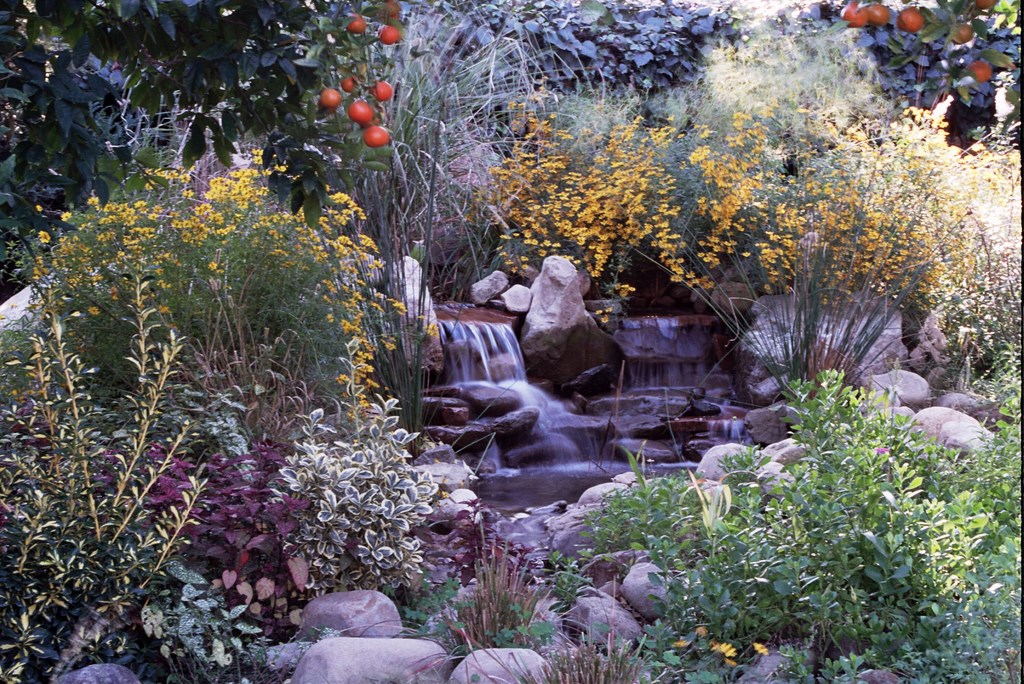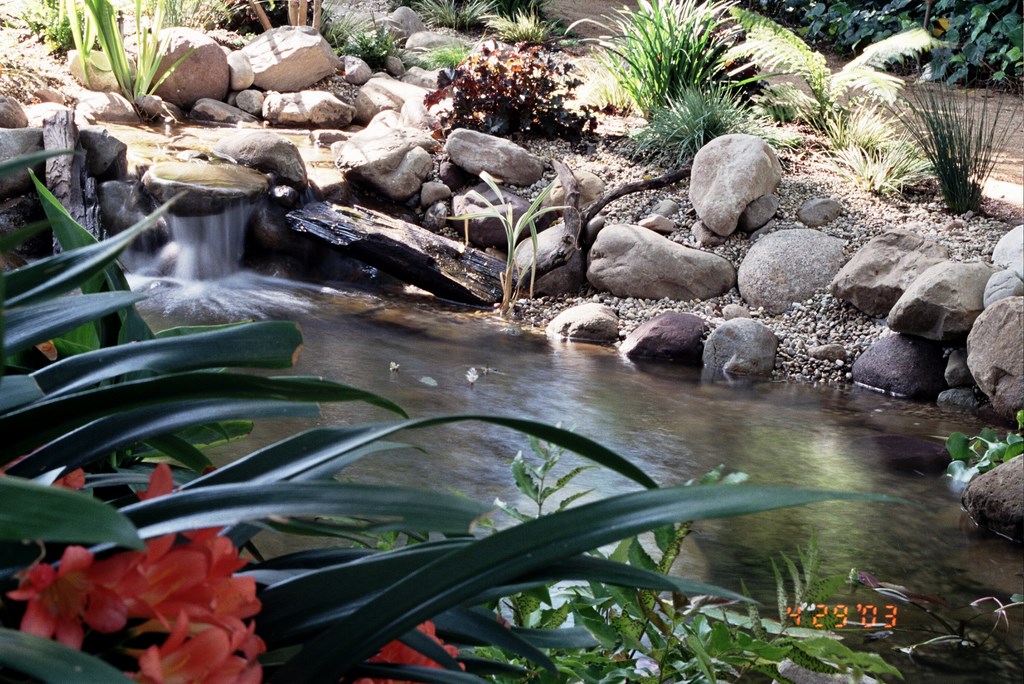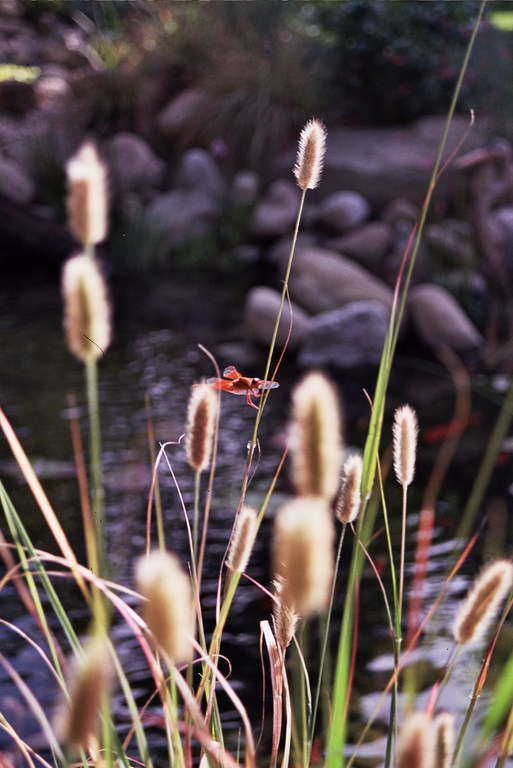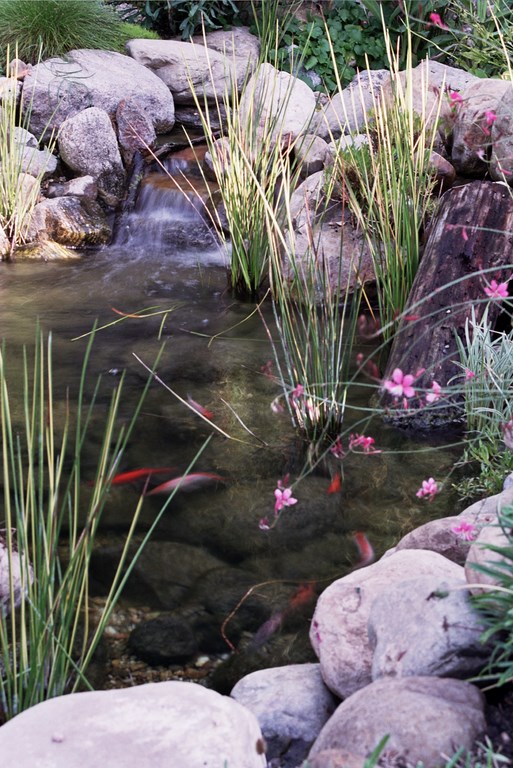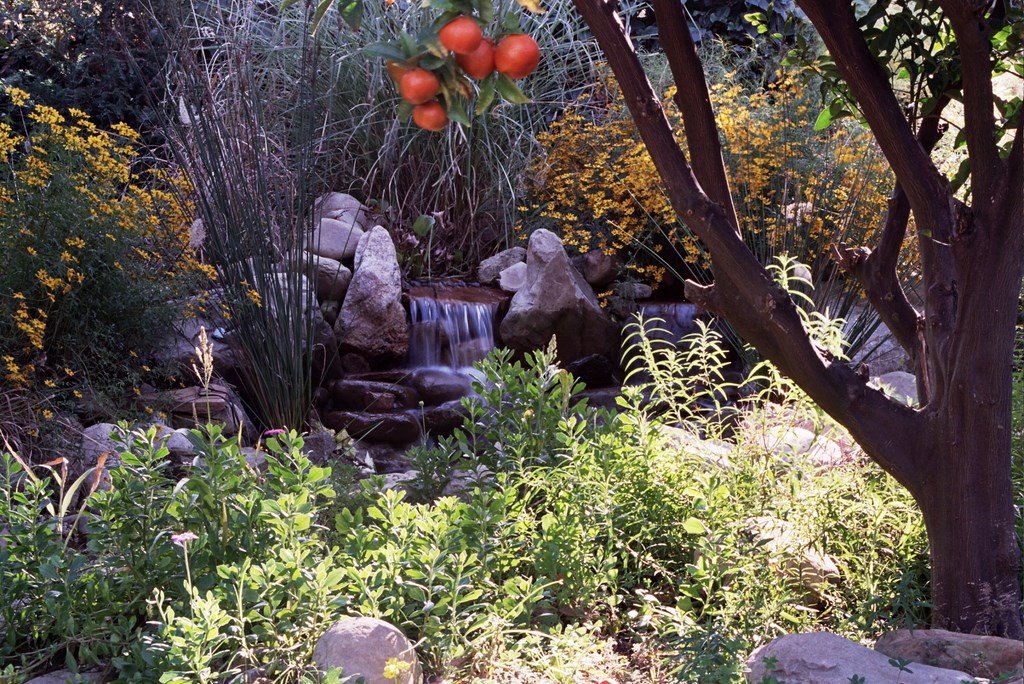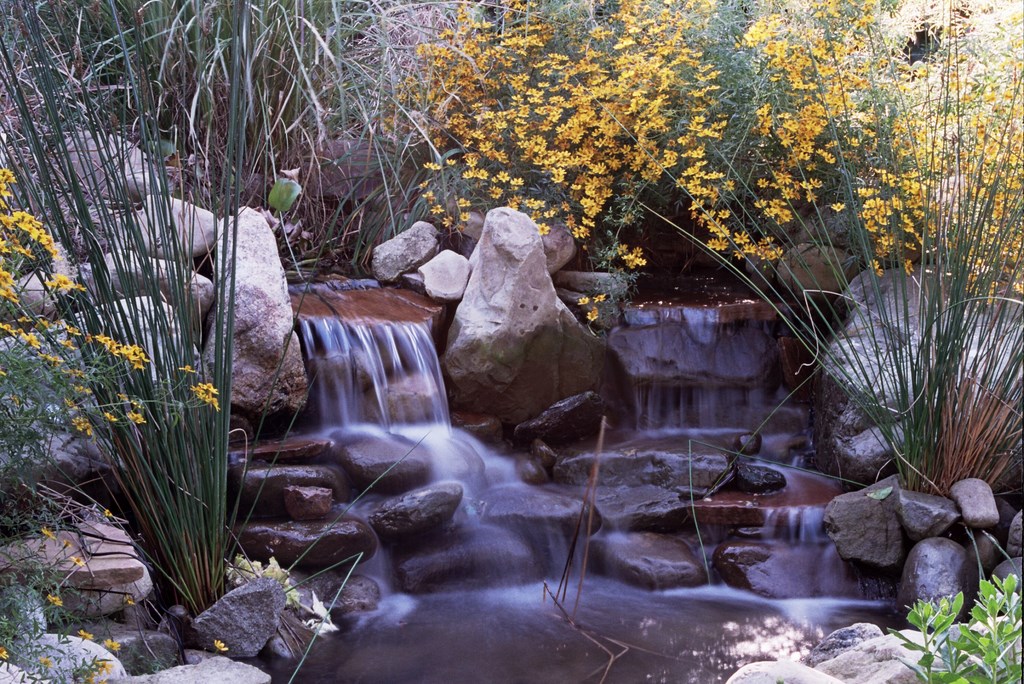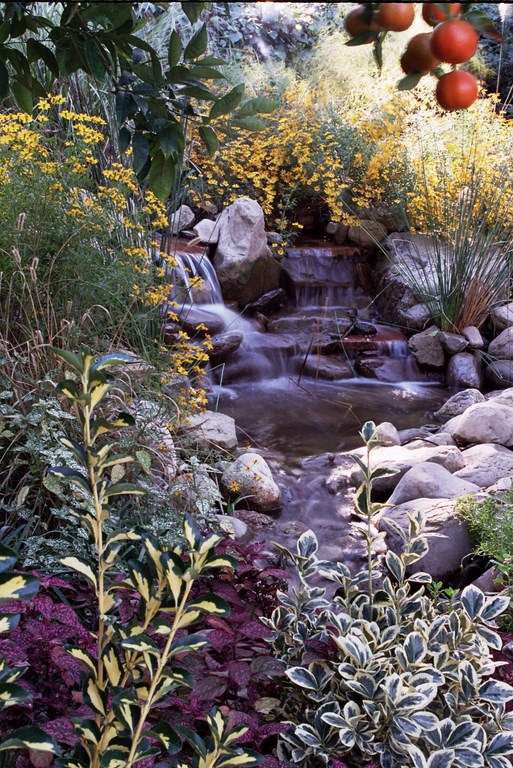A Fine Romance

I believe it’s fair to say that many of us who are now in the business of creating naturalistic watershapes have been intensely influenced and inspired by experiences we had as children playing near streams, waterfalls and ponds.
That was certainly true for me as a kid growing up on Long Island, N.Y., where I was constantly exposed to beautiful natural bodies of water. When I grew up, I found myself in the entertainment industry for several years. It was exciting at times, but no matter where I went, I always felt myself being drawn back to the water’s edge.
About ten years ago, at a point where my interest in acting and modeling had begun to wane, my wife and I decided to settle down and bought a home. It wasn’t long before I started thinking about building a stream in the backyard to recapture my childhood sense of wonder at being surrounded by natural beauty – and it wasn’t long before I became a bit obsessed by working with water.
At first it was just a serious hobby. I’d spend hours fine-tuning our stream and couldn’t wait to get back to the water when I was off doing other things. Not much time passed before I started putting streams in the backyards of friends who’d seen ours. Soon, almost without knowing it, I became a watershaper and had left the entertainment industry far behind.
About five years ago, I opened my own company, Mystic Water Gardens of Encino, Calif., and am now entirely devoted to this wonderful medium of aquatic art and the power it has to transform almost any garden into a place where peace and tranquility reign.
KEY COLLABORATIONS
Despite the fact that my journey from the world of acting and modeling into building ponds and streams was more or less accidental, I have taken to it with unmistakable passion and have found every step of my progress as a professional to be endlessly rewarding.
It’s never really felt like a job, even though it can involve an incredible amount of hard, physical labor. And I think I see an advantage in having come at it as a homeowner/do-it-myselfer, because I learned just how profoundly a beautiful stream can affect one’s daily life. Absolutely, my approach to my clients’ projects has always been informed by that personal sense of conjuring pleasure and tranquility.
At the same time, I appreciate the fact that one of the most exciting things about this line of work is that it’s impossible to know everything. Each and every project provides me with an opportunity to fine-tune my craft and learn and apply new skills and techniques.
The fact that I’m so open to new approaches and ways of thinking is one of the reasons I’ve taken the somewhat unusual approach of networking with every pond builder in my area who’s willing to talk with me. We share ideas and methods, discuss projects and challenges – and generally work as colleagues in creating more exceptional watershapes for our clients.
The way I see it, the demand for naturalistic watershapes has expanded so rapidly that there’s more than enough work for everyone who’s already in the field – and then some. By cooperating with each other and operating with a collective pool of insight, skill and experience, we’re all better able to meet clients’ needs and expectations.
The alternative, which would have us approach each other as competitors wary of one another, doesn’t make much sense to me. Of course, I understand the natural inclination some people have to protect their businesses and their knowledge bases, but I’ve found that cooperation has created a positive working culture within the local trade that makes life more pleasant and enjoyable – and has actually opened doors for all of us.
I see this spirit of cooperation and collective energy as crucial to the success of any of my projects, no matter how small or large. If my mission is to create pockets of relaxation and beauty, it makes sense to me that the entire process should move forward with an open, positive spirit.
PLANNED IMPROVISATIONS
Good intentions and creative openness are one thing, but the actual planning and installing of these features is quite another and takes lots of hard, detailed work.
I start by talking with the clients to get an idea of what they’re really after, taking cues as I listen to them from the way they talk about their home and the lifestyle they’re after for themselves, their families and friends. I also spend a great deal of time on site, studying the lay of the land, thinking through possible focal points and figuring out the vertical transitions.
If there’s a natural slope, I consider what would be the most natural course for water and think things through accordingly. When I’m dealing with a flat space, I envision subtle vertical transitions that don’t go too far toward violating the nature of the setting while still providing adequate drops from the top of the system to the bottom. This can mean grading the lot and adding soft contours, or it might entail over-excavating the stream course to provide depth for necessary transitions.
| ‘Each and every project provides me with an opportunity to fine-tune my craft and learn and apply new skills and techniques.’ |
I’ll sketch ideas to give my clients a basic feel for the end result, but the thing about naturalistic watershaping is that showing the general stream course and/or pond size and location is about all you can do: Almost all of the detail comes as work progresses on site.
In other words, for all the careful planning that goes into conceiving them, streams and ponds don’t lend themselves to precise designs on paper. Mostly that’s because rockwork is an improvisational art form: We select stones with interesting features but only start piecing them together when the real work starts. Those outcomes aren’t very predictable, and I’m always confronting the balances between meeting expectations and working with fluid combinations of topography and rock materials.
In my book, the only way you can understand how those relationships work is by studying nature. Indeed, when I started down this professional path, I spent a great deal of time in local mountains studying natural streams to get a sense of the randomness of their natural patterns. In setting stone, we work to mimic those patterns using a wide range of stone sizes, using some as major focal points within the stream and others to create a sense of the natural dispersion of stones by floodwaters.
STONE FACTORS
Whenever possible, I try to work with stones that are indigenous to the area in which I’m working. I’ve seen some projects that look fantastic except for the fact that the materials have nothing to do with local environments. This is why I always tell clients that their watershapes will be better served using materials that can be seen locally, because the alternative might involve creating a system that looks as though it’s been picked up from some exotic region and plopped in their backyard.
As important as working with local material is the exercise of a great deal of care in selecting individual stones. In our projects, we carefully sort through the materials, setting aside pieces with an idea in mind of where they’ll specifically be used in the design. I’m always intrigued by pieces that have weathered surfaces, interesting shapes and textures and signs of character such as moss or lichen – but if they don’t fit within my particular set of design parameters, I’ll leave them behind.
Once the selected materials arrive on site, we start the process of positioning and repositioning each piece until everything looks and feels right. This is a crucial stage for us, because we know we are essentially setting the “bones” of the watergarden. It doesn’t hurt that I work with craftspeople who have years of experience in working with stone and possess a knack for placing them in wonderfully artistic ways.
Every piece is important, of course, but we spend relatively more of our time detailing the waterfall areas to create a level of natural complexity. We rarely see water spilling over a dramatic weir in nature (although it does happen); more often, we see flows of water down slopes highlighted by waterfall fragments. This is why our designs are marked by lots of small pools with irregular weir edges and rivulets of water that divide and recombine. Not only does this look more “natural” to me, but it also gives us the opportunity to “tune” the sound of the falling water.
Once the bones are set and the waterfalls make sense to us, we attend to the edges and work very hard to blur the boundary between the stream and the surrounding landscape. Distributing rock material in the water, at the waterline and outside the stream course is our key to binding stream and landscape together.
In all cases, we studiously avoid the dreaded “string-of-pearls” effect in which a line of similarly sized stones marks a pond or stream edge. One of the keys to avoiding even the suggestion of such a line involves the strategic use of plantings to partially or even completely obscure some stones along the edges.
FLORA AND FAUNA
When it comes to functionality of our water systems, I’m a big fan of making them self-sustaining, which in almost all cases means extensive use of aquatic plants. Not only do plants add to the natural beauty of almost any system, but they are also critical to maintaining top-notch water quality.
To that end, we set up pockets and shelves for hyacinths, water lettuce and lilies throughout the system. The root systems absorb nutrients, which in turn promotes clear water – and the plants go crazy.
For filtration, I prefer to set up bog-type systems in which water wells up through a layer of gravel, rock and plant roots. To me, that technique is far more desirable than deploying large, separate filter systems to perform a job that nature is more than capable of handling if systems are built correctly. I’ve encountered some people who seem more impressed with an elaborate equipment pad than they are with the watershape itself, but I have the feeling that if my job had more to do with engineering mechanical sorts of systems, I wouldn’t be nearly as enthusiastic about it.
| ‘For all the careful planning that goes into conceiving them, streams and ponds don’t lend themselves to precise designs on paper.’ |
Fortunately, natural filtration, chemical uptake by aquatic plants and the natural aerating action of waterfalls combine to give me the option of keeping equipment use to a minimum. From time to time, we’ll run into water-quality issues related to issues such as fertilizer runoff, but for the most part our systems have always been self-sustaining.
And there’s nothing better in these systems than clear water. It draws observers’ eye first to the water’s surface and then into the depths, where underwater rockwork, fish, turtles and other animals offer diversion and even a sense of wonder. Most of my projects include Koi, and I’ve heard over and over again from clients that these colorful fish have become cherished pets, each with a distinct personality.
Again, the use of extensive plantings helps keep fish-bearing water clean – and also gives fish a place to hide from predators or escape the heat of summer.
I never lose sight of the fact that I’m in business to provide my clients with exactly these sorts of full-spectrum sensory experiences. It may all have started in my own backyard, but with each succeeding project, I keep uncovering new ways to embrace a sense of romance and spiritual beauty in my work. Fish and plants have always been key components in that mix, but now I’m drawn as well to the use of artwork, underwater lighting, fire elements and more to accomplish my mission.
FINISHING TOUCHES
That word I just used – romance – is increasingly the focus of my work in clients’ backyards, and it’s a goal that can be achieved in myriad ways.
In daylight hours, it’s all about personalizing a space and getting my clients involved in making the watershape their own. Design elements as simple as bridges, benches and stepping stones that create pathways and destinations can get this job done, as can developing elements of surprise that reward those who venture off into the landscape to find the source of certain sounds, whether it’s water in motion or the rustling of reeds.
When the sun goes down, the setting can be even more magical and romantic. Whether it’s using soft lights to accent certain plants or stones or setting up torches or fire rings to enhance the beauty of the setting at night – or even leaving the job entirely up to moonlight – we look at shadows and light to create a mood and atmosphere in which the daily grind falls away and romance prevails.
Many of these features are planned into a project, but many times they find their ways into the garden after we’ve completed the job. In fact, it’s enormously gratifying to return to a site and see what the clients have done on their own. Sometimes what I find is a bit disconcerting, but what the simple effort on their part tells me is that they are interacting with the environment in ways none of us could have predicted and that they are willing to get their hands dirty to add finishing touches of their own.
In other words, the fact that they’ve made the pond and stream interactive is brilliant affirmation that they’re spending time outside, caught up in the romance of the setting and making it completely theirs to enjoy. This is where I find my greatest joy in designing and building streams, waterfalls and ponds: It’s the sort of work that sets your creative spirit free and enables you to bring beauty and tranquility to people’s lives.
There’s nothing I’d rather do!
Steve Sandalis is founder and president of Mystic Water Gardens, an Encino, Calif.-based designer and installer of custom streams, waterfalls and ponds. Sandalis founded the firm in 2000 after several years of pursuing watergardening as a serious hobby. Since then, he has immersed himself in arts and crafts of watershaping and currently designs and installs highly detailed watershapes for a range of mostly residential customers across the United States. A former model and actor, Sandalis appeared on more than 700 covers of romance novels published by Topaz, a division of Penguin Books, and has appeared in a variety of movies, television programs and commercials. A native of Commack, N.Y., he began working in the construction trades as a child with his father and uncles – all of them contractors in the area.











